甜瓜属于葫芦科植物,是新疆的特产水果之一。甜瓜被人们称为“瓜中之王”,是水果中的佳品[1],这是因为新疆具有独特的气候、地理、环境等优势,种植的甜瓜具有甘之如蜜、风味袭人、含糖量高等特点。甜瓜有很高的营养价值,例如在干物质中含纤维素最高可达6.7%,糖分最高可达15.8%,维生素含量分别比西瓜、苹果、杏高4~7、6、1.3倍,Fe含量是牛奶的18倍,是鸡肉的2~3倍[2],还有果胶、苹果酸、以及Ca、P等元素,这些成分对人的肠道消化有促进作用。研究表明,甜瓜汁还具有一定的抗菌效果[3]。
现在市面上主要是发酵型乳酸饮料、调配饮品,浓缩果汁等,这些加工领域在国内外研究中取得了较多的成果,还有一些市售产品有甜瓜酸奶、果肉、果脯等[4],这些种类的甜瓜产品耐贮藏、颜色风味保留较好,但与非浓缩还原(not from concentrate,NFC)甜瓜汁相比在口感、营养物质等方面还有一定差距。鲜榨果蔬汁能够有效提高人体免疫力,例如可以提高人体内的淋巴细胞[5]及巨噬细胞活性。一些研究表明非热力加工技术即超高压均质技术对果汁中酵母菌[6-7]、引起果汁败坏的真菌孢子[8]、和致病菌[9-11]等有明显抑制或杀灭作用,在保障果蔬汁安全方面、营养方面有很大优势。
目前超高压均质技术已应用到化学[12]、生物、制药等行业中,主要用于减小颗粒粒径、提取代谢产物、破碎分散体等[11]。超高压均质处理能够最大程度地保留食品原有的风味,不破坏食物的营养物质与原始风味,保持了食物的生鲜特性[13]。鉴于甜瓜汁产品在市场上所占份额较小,探究如何将甜瓜进行进一步加工是目前刻不容缓的问题,超高压均质技术能使果汁的稳定性更高,果汁颗粒大小会随均质压力大小而产生变化,另外甜瓜最重要的品质之一就是它独特的香气,但甜瓜汁属于热敏性果汁,传统的热处理会导致其香气、口感、营养成分的损失,高温处理会使甜瓜汁产生类似“南瓜蒸煮”味,而采用超高压均质技术可能是解决甜瓜汁加热变味难题的有效方法。近年来根据消费者对于果汁喜好度的研究显示,消费者们对于果汁的流变特性,如黏度、黏弹性、黏滑性等关注越来越多[14-15],果汁流变性指标与果汁口感、感官等食用品质密切相关,其变化特性对鲜榨果汁加工技术改进、创新具有重要的指导意义[16-17]。本文利用超高压均质技术,经超高压均质以不同的均质压力(20、60、100、140、180 MPa)、均质次数(1、2、3次)、均质温度(25、35、45、55 ℃)处理后,采用流变仪分别检测了这些指标,包括静态流变黏度、动态频率和温度扫描,以掌握其NFC甜瓜汁的流变学特性,为NFC甜瓜汁的加工及创新提供了理论依据。
1 材料与方法
1.1 材料
选取品种为新鲜、成熟度良好的西州蜜25号甜瓜,产地新疆吐鲁番,乌鲁木齐市新北园春。
1.2 仪器与设备
JN-Mini Pro超高压均质机,广东聚能纳米生物科技有限公司;MCR92流变仪,奥地利Anton Paar公司的旋转流变仪;筛网(20目),绍兴市上虞张兴纱筛厂;M450打浆机,中山市禧膳电器有限公司;JM-LB65胶体磨,温州七星胶体磨机械制造有限公司;
1.3 实验方法
1.3.1 样品制备
将新鲜西州蜜25号甜瓜清洗后,手工去皮去瓤,切成1.5 cm×1.5 cm瓜块,用打浆机打浆(<30 s),过胶体磨后用20目筛网过滤,经超高压均质处理后,在4 ℃冰箱保存备用。
1.3.2 参数设定
本实验设定超高压均质压力为20、60、100、140、180 MPa;进料温度为25、35、45、55 ℃;均质次数为1、2、3次;2个对照:CK(未处理)、巴氏(经巴氏杀菌)。
1.3.3 流变学性质的测定
1.3.3.1 NFC甜瓜汁静态流变学测定
NFC甜瓜汁的黏度曲线,采用流变仪,选取平板转子(直径49.983 mm,间隙1 mm),使用水循环系统控制测定温度为(25±1) ℃。取 2.5 mL甜瓜汁汁置于夹具和平板转子之间,在稳态剪切模式下,设置剪切速率从0.01 s-1指数增加到 100 s-1,剪切黏度随剪切速率的变化[18]。
1.3.3.2 NFC甜瓜汁动态流变频率测定
采用流变仪,平板转子,用水循环系统控制测定温度为(25±1) ℃。在振荡剪切模式下,应变振幅为1%,频率由0.1 Hz增加到10 Hz,记录储能模量(G′)和损耗模量(G″)随频率的变化。
1.3.3.3 NFC甜瓜汁动态流变温度测定
采用旋转流变仪、平板转子温度由20 ℃增加到60 ℃。在振荡剪切模式下,应变振幅为1%,频率1 Hz,记录G′和G″随频率的变化。
1.4 数据处理
本实验采用Excel 2020、Origin 2019、SPSS 20.0软件进行数据的分析和处理。
2 结果与分析
2.1 NFC甜瓜汁静态流变特性分析
如图1所示为均质压力对NFC甜瓜汁黏度曲线图。随着剪切速率的不断增加,剪切黏度逐渐减小,出现了剪切稀化的现象,这是典型的非牛顿流体,呈现假塑性行为[19-20],此结果与超高压均质处理后苹果汁[21]、果汁模型[22]、哈密瓜汁[20]、菠萝果肉果汁[23]的黏度变化趋势一致。由图1可知,当均质温度为25 ℃,均质次数为1次,均质压力增大时,NFC甜瓜汁的黏度逐渐下降,这一结果跟尹琳琳[19]一致,这可能是因为随着剪切速率的增大,NFC甜瓜汁中的果胶物质受到破坏,使得黏度变小。AUGUSTO等[21]研究发现,苹果汁表观黏度随压力(0~150 MPa)的升高逐渐升高,随着处理压力的增加,其破坏程度增大,可能是由于超高压均质处理使得更多大分子物质溶出。
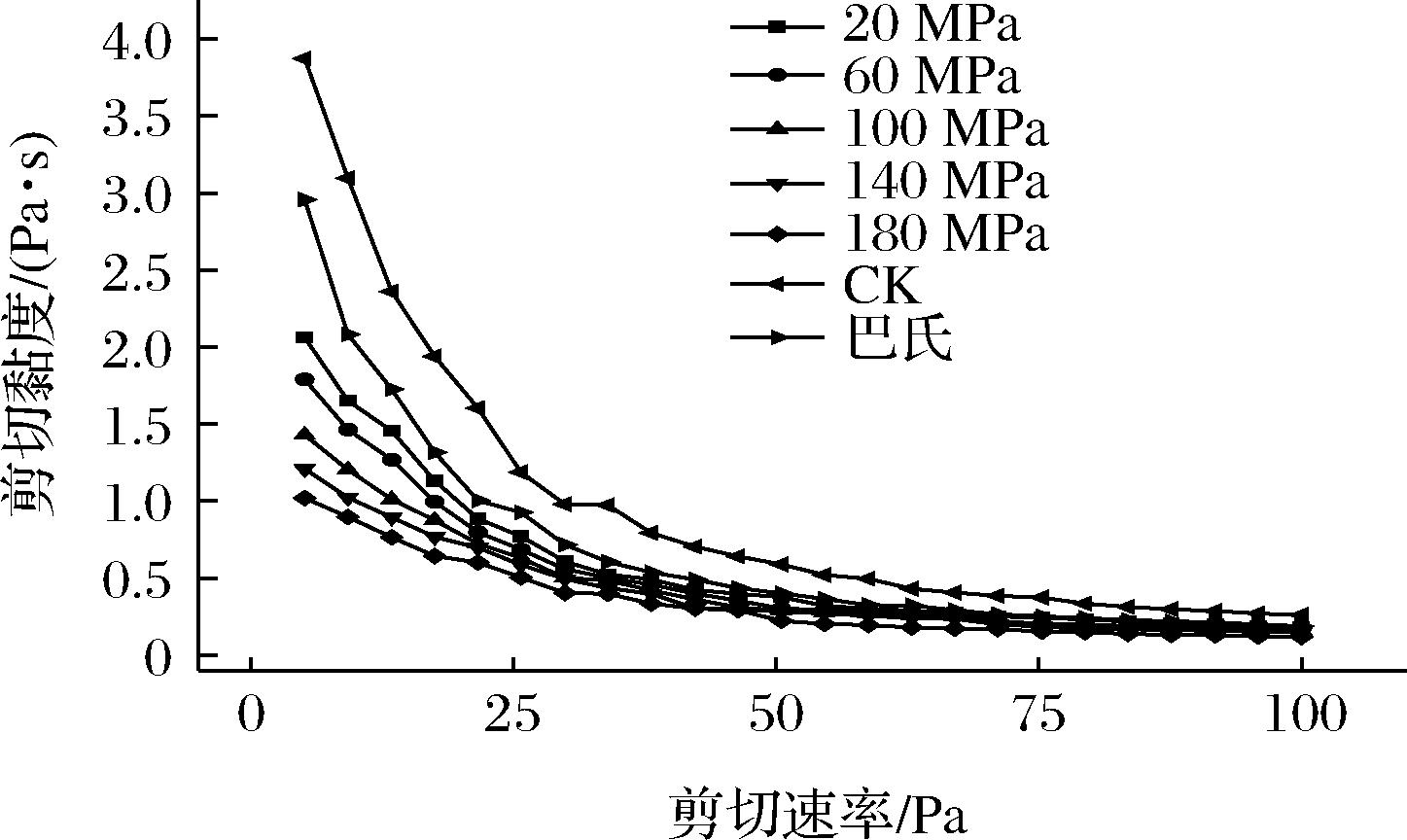
图1 不同均质压力对NFC甜瓜汁黏度的影响
Fig.1 Influence of different homogenization pressure on viscosity of NFC melon juice
如图2所示为不同的均质温度对NFC黏度的影响。由图2可知,均质压力为140 MPa、均质次数为1的条件下,随着均质温度的不断增加,NFC甜瓜汁的黏度不断减小,即剪切稀化明显,这是因为温度的不断升高加速了NFC甜瓜汁中大分子物质果胶的溶出。经巴氏杀菌的黏度比经超高压均质过的要高,这可能是由于温度的升高,体系中分子运动加剧,分子间距增大,分子间作用力减小,流动时的摩擦力减小,黏度降低[21],此结果与芒果汁黏度变化[24]一致。
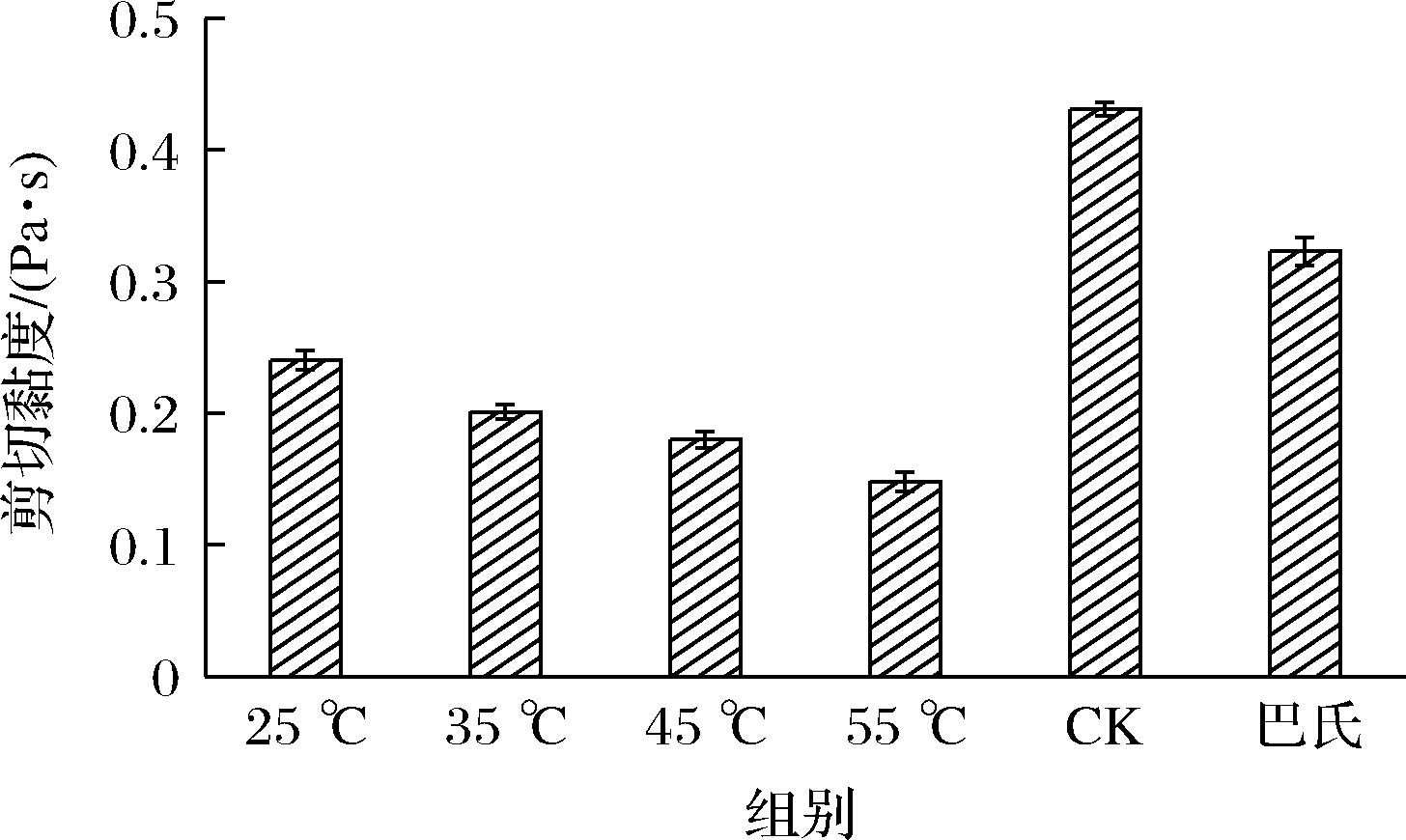
图2 不同均质温度对NFC甜瓜汁黏度的影响
Fig.2 Effect of homogenization temperature on viscosity of NFC melon juice
图3为不同均质次数对NFC甜瓜汁黏度的影响。由图3可知,当均质温度为25 ℃、均质压力为140 MPa时,随着均质次数的增加,NFC甜瓜汁的黏度大小为:140 MPa、25 ℃、1次>140 MPa、25 ℃、3次>140 MPa、25 ℃、2次,即先减小后增加,此结果与芒果汁[24]的黏度变化相反,这可能是因为NFC甜瓜汁在140 MPa高压下均质3次加速了果胶、蛋白质分子等物质溶出。
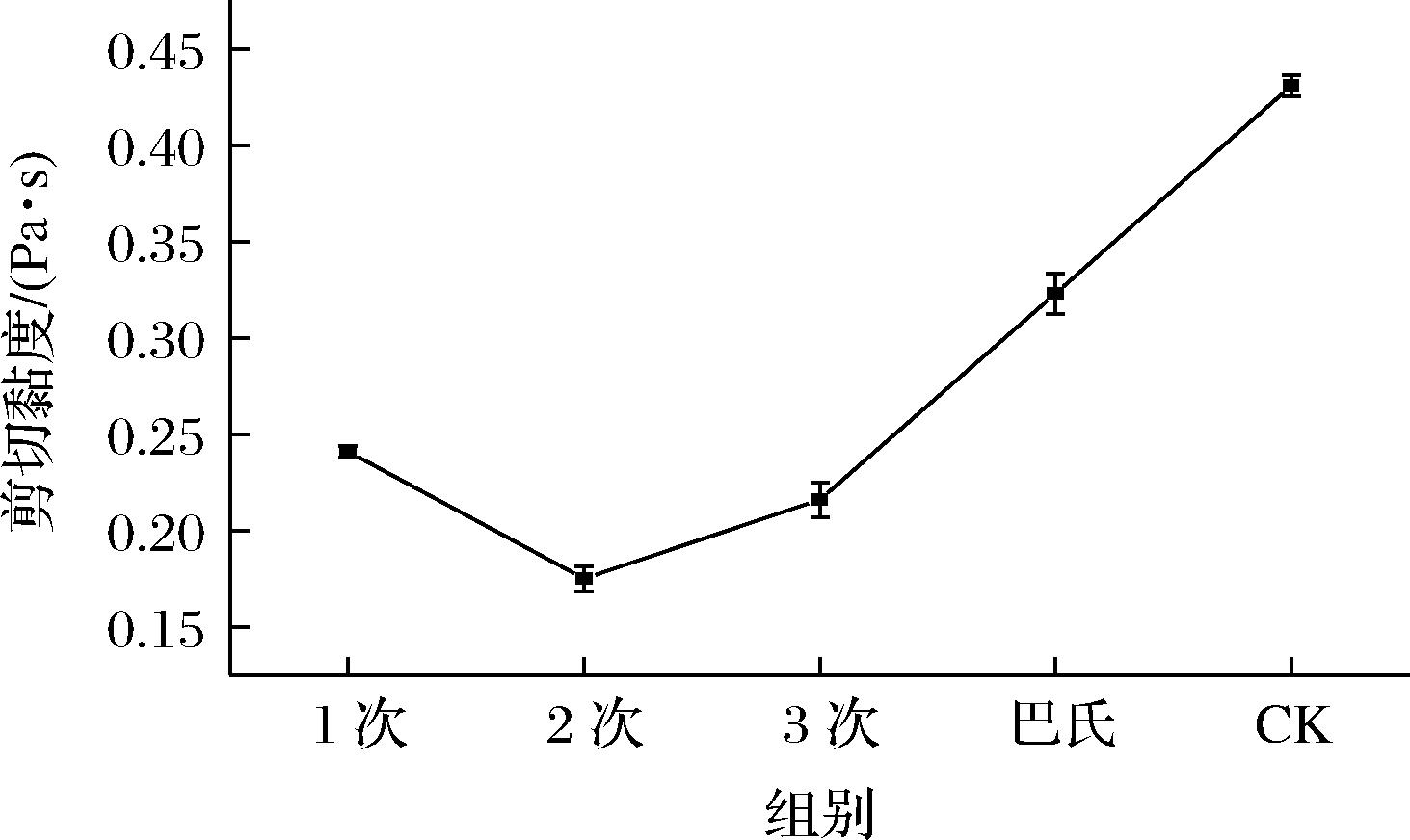
图3 不同均质次数对NFC甜瓜汁黏度的影响
Fig.3 Effects of different homogenization times on viscosity of NFC melon juice
2.2 NFC甜瓜汁频率扫描动态流变学分析
动态流变仪是分析样品的G′和G″的一种重要手段,可以分为温度扫描和频率扫描,频率和温度扫描就是通过改变振荡频率和温度来分析物质的弹性和黏性的情况,即G′和G″变化的一种测定方法[25]。
如图4~图6所示为超高压均质不同处理压力、次数、温度对NFC甜瓜汁频率扫描中的G′和G″的变化,G′>G″表示体系属于凝胶体系,G′<G″表示体系属于溶胶体系,一般G′/G″越大表示体系流动性越好[26-27]。由图可知,G′>G″,NFC甜瓜汁属于弱凝胶体系;随着频率的增加,NFC甜瓜汁的G′和G″整体呈缓慢上升状态,该结果与萝卜汁[18]、芒果汁[24]的G′和G″趋势一致。与超高压均质处理过的NFC甜瓜汁相比,CK和巴氏的NFC甜瓜汁的G′和G″高于超高压均质处理过的,这可能是由于超高压均质破坏了NFC甜瓜汁中的分子结构,从而产生较弱的结合力,使黏度下降[18]。
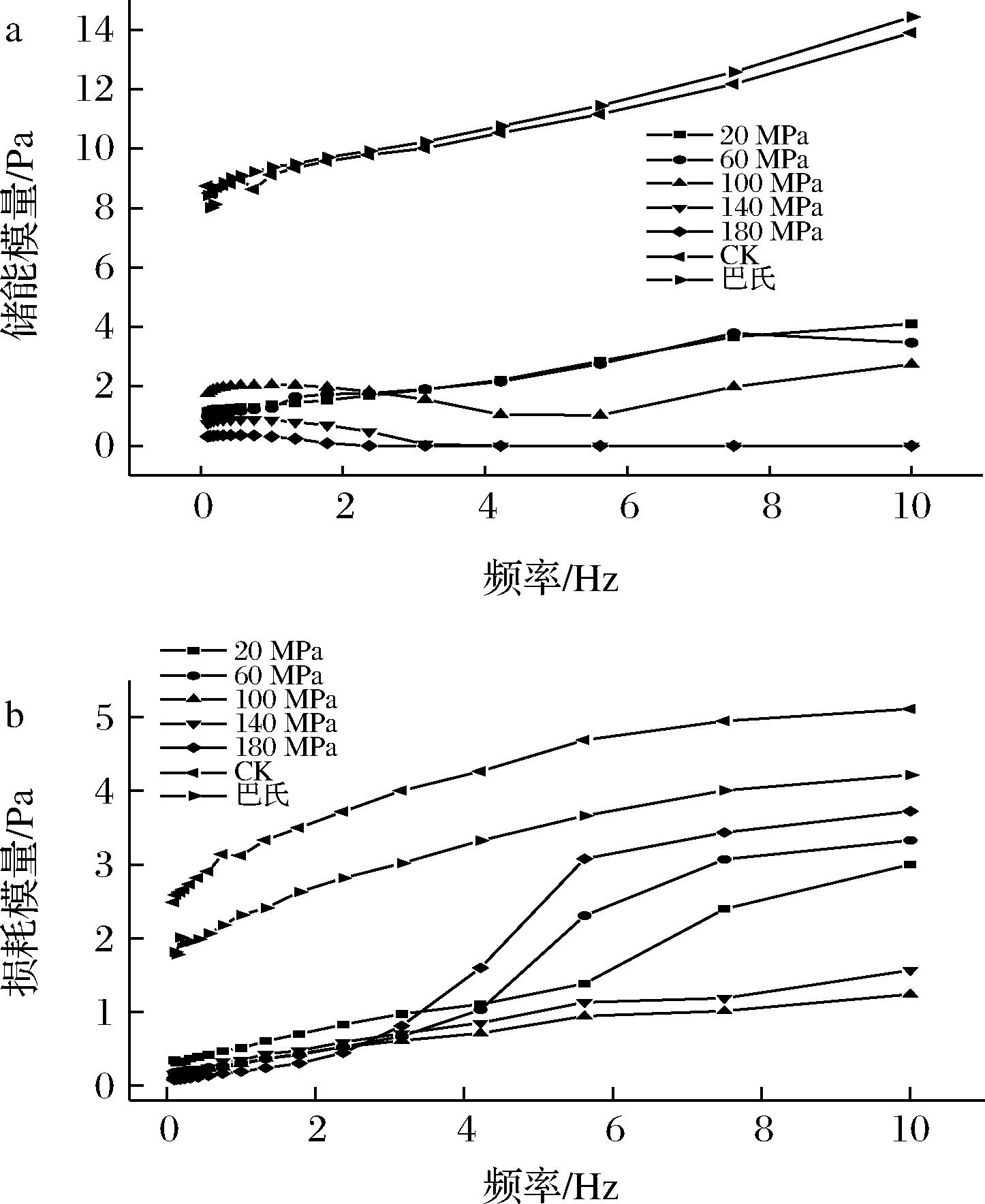
a-储能模量;b-损耗模量
图4 不同均质压力对NFC甜瓜汁的频率扫描曲线
Fig.4 Frequency scanning curve of NFC melon juice under different homogenization pressure
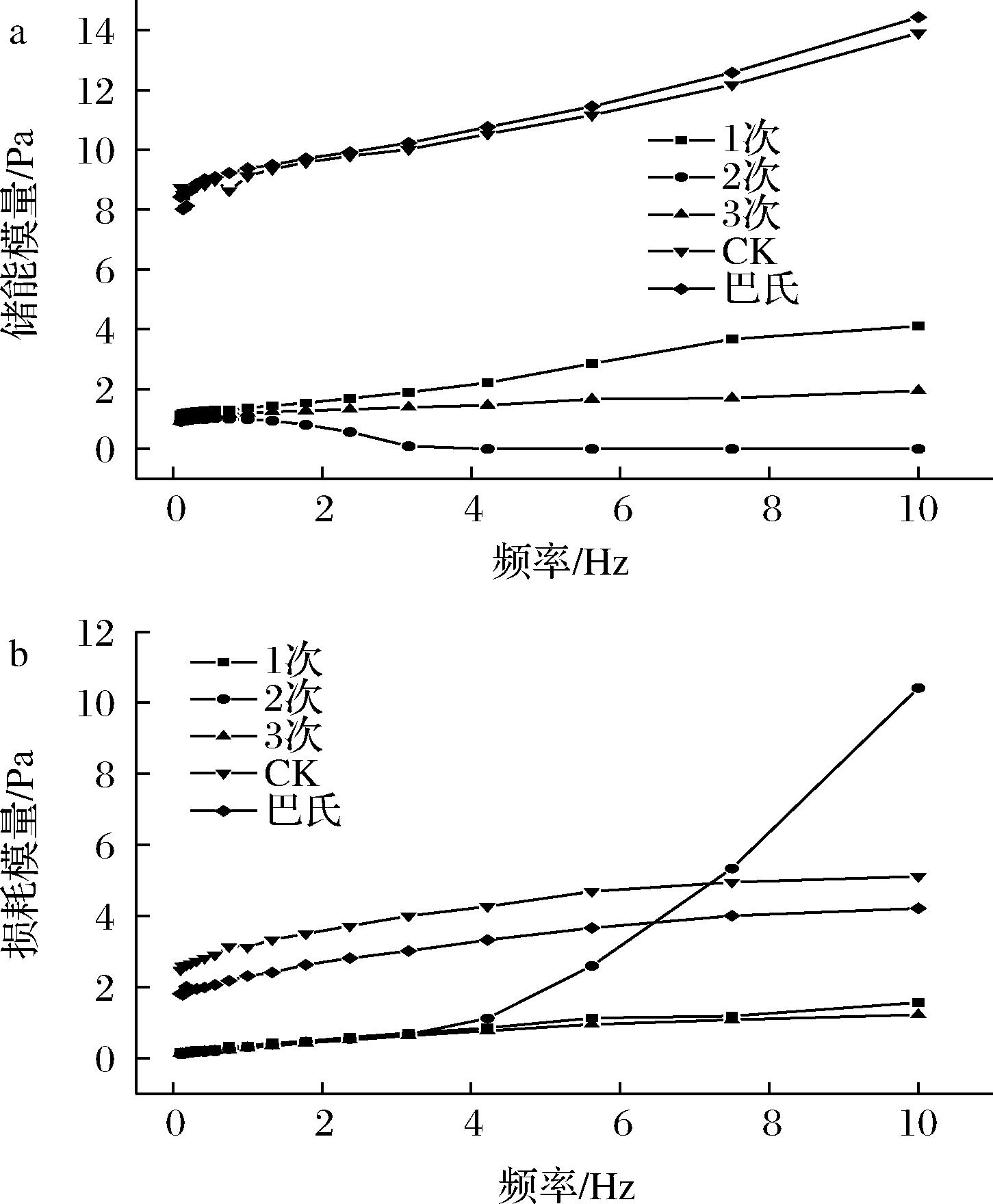
a-储能模量;b-损耗模量
图5 不同均质次数对NFC甜瓜汁的频率扫描曲线
Fig.5 Frequency scanning curve of NFC melon juice with different homogenization times
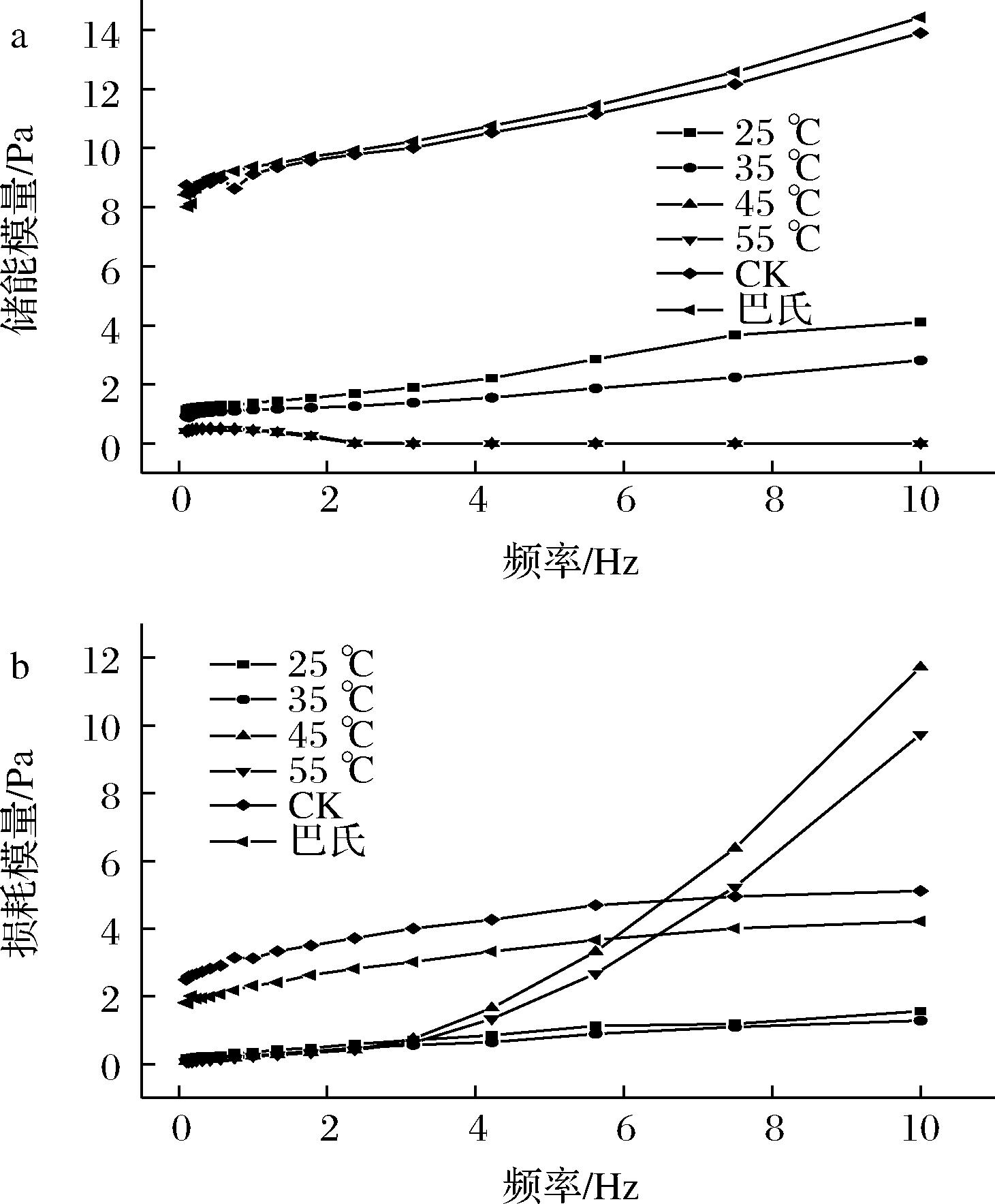
a-储能模量;b-损耗模量
图6 不同均质温度对NFC甜瓜汁的频率扫描曲线
Fig.6 Frequency scanning curves of NFC melon juice at different homogenization temperatures
如图4-a、图4-b所示为不同均质压力对NFC甜瓜汁的频率扫描曲线,当均质温度为25 ℃、均质次数为1次时,随着均质压力不断增加,G′逐渐减小,G″逐渐增大,但始终小于G′,G′>G″,即弹性大于黏性;图5-a、图5-b为不同均质次数对NFC甜瓜汁的频率扫描曲线,当均质压力为140 MPa、均质温度是25 ℃,随着均质次数的增加,G′大小为:140 MPa、25 ℃、1次>140 MPa、25 ℃、3次>140 MPa、25 ℃、2次,G″与之相反,频率在4 Hz时均质,均质2次的NFC甜瓜汁的G″迅速上升,即:140 MPa、25 ℃、2次>140 MPa、25 ℃、1次>140 MPa、25 ℃、3次。图6-a、图6-b是不同的均质温度对NFC甜瓜汁的频率扫描曲线,当均质压力为140 MPa、均质次数为1次,随着均质温度不断增加,G′逐渐降低,G″逐渐升高,当均质温度为45、55 ℃时,G′几乎一致,当频率大于3 Hz时,均质压力为140 MPa、均质次数为1次、均质温度分为45、55 ℃时,G″迅速增高,这可能是由于温度的不断升高,NFC甜瓜汁在热处理过程中纤维链之间的颗粒发生“膨胀”引起的[28],综上所述,随着频率的不断增加,NFC甜瓜汁的G′和G″整体呈缓慢上升趋势,巴氏跟CK的G′逐渐增加,G′始终大于G″,NFC甜瓜汁具有凝胶特性,说明动态频率扫描会影响NFC甜瓜汁的流变。
2.3 NFC甜瓜汁温度扫描动态流变学分析
如图7~图9所示为NFC甜瓜汁温度扫描动态流变学曲线。扫描温度为20~60 ℃,随着扫描温度的不断升高,G′和G″也在逐渐升高,扫描温度大于30 ℃时,上升幅度逐渐变大,且G′增加幅度大于G″,这可能是由于NFC甜瓜汁随着扫描温度的不断升高,结构会发生变化,分子逐渐展开,分子动能增加,使得NFC甜瓜汁流动性增强,黏度降低[29]。如图7-a、图7-b所示为不同均质压力对NFC甜瓜汁的温度扫描曲线,均质温度为25 ℃、均质次数为1时,随着均质压力的增大,NFC甜瓜汁的G′和G″不断减小,均质压力在20 MPa时,G′和G″达到最大,均质压力在180 MPa时,G′和G″达到最小,均质压力越大,“弱凝胶”结构越容易被破坏,G′和G″的降低表示NFC甜瓜汁的储能模量(弹性)和损耗模量(黏性)降低,饮用时的口感逐渐偏向于清汁[30]。巴氏和CK相比,CK的G′和G″整体呈上升趋势,与超高压均质处理过NFC甜瓜汁相比,巴氏跟CK的G′和G″呈上升趋势,这与扫描频率结果一致。图8-a、图8-b为不同均质温度对NFC甜瓜汁的温度扫描曲线。当均质压力为140 MPa、均质次数为1时,随着均质温度的升高,G′和G″不断减小,这可能是因为随着温度升高,NFC甜瓜汁的分子能量增大,分子之间的聚合能力下降,使得有效容积率降低,黏度也因此下降[31]。图9-a、图9-b为不同均质次数对NFC甜瓜汁温度扫描曲线。由图可知,当均质压力为140 MPa、均质温度为25 ℃时,随着均质次数的增加,G′和G″逐渐减小。综上所述,随着扫描温度的不断升高,NFC甜瓜汁的G′和G″呈上升趋势;且G′>G″,属于弱凝胶特性,该结果与频率扫描基本一致,但温度扫描显著提高了NFC甜瓜汁的G′和G″。
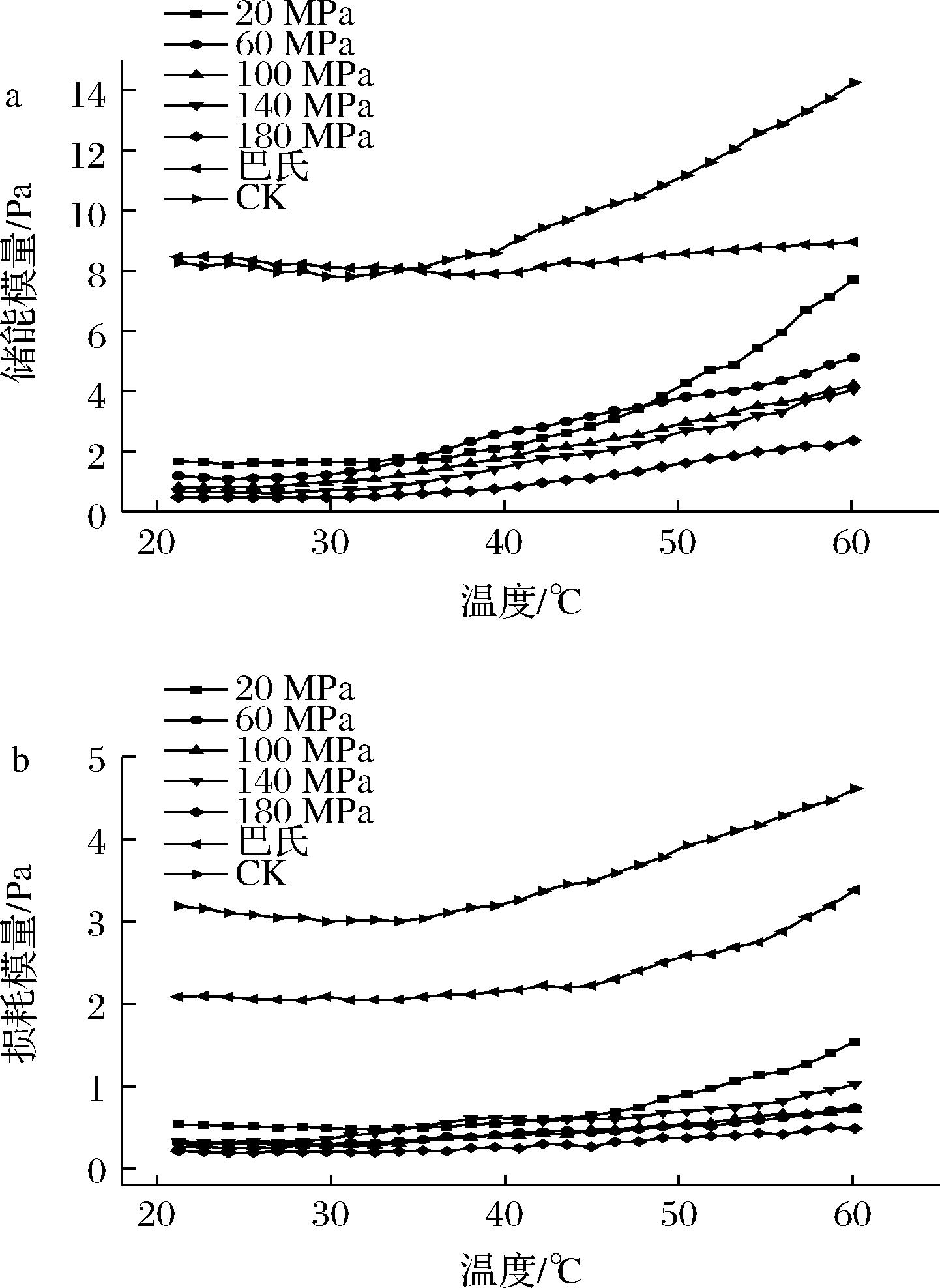
a-储能模量;b-损耗模量
图7 不同均质压力对NFC甜瓜汁的温度扫描曲线
Fig.7 Temperature scanning curve of NFC melon juice under different homogenization pressur
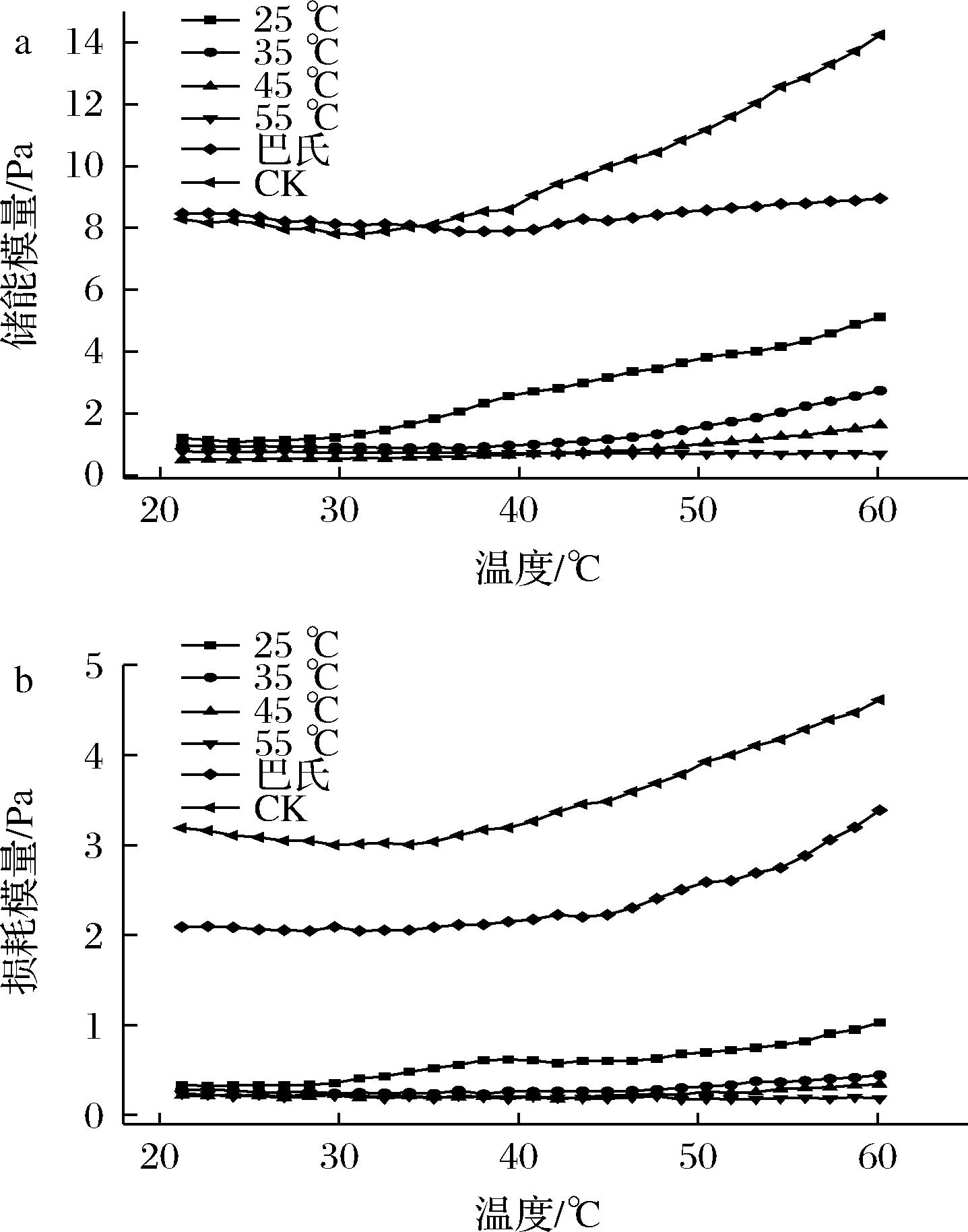
a-储能模量;b-损耗模量
图8 不同均质温度对NFC甜瓜汁温度扫描曲线
Fig.8 Temperature scanning curve of NFC melon juice under different homogenization temperature
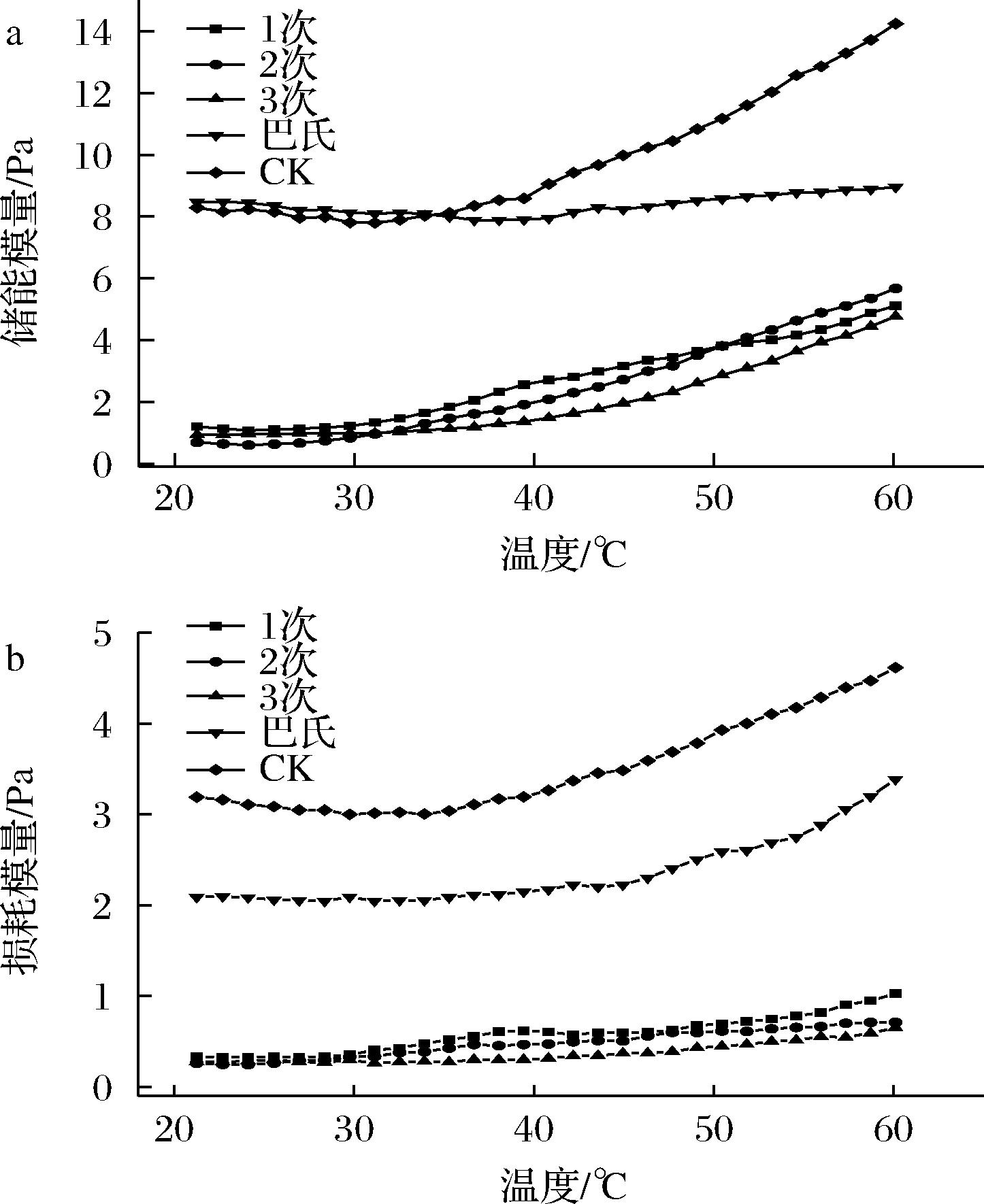
a-储能模量;b-损耗模量
图9 不同均质次数对NFC甜瓜汁温度扫描曲线
Fig.9 Temperature scanning curve of NFC melon juice with different homogenization times
3 结论
超高压均质处理可以改变NFC甜瓜汁的流变学性质。NFC甜瓜汁属于非牛顿流体,具有假塑性行为。由静态黏度曲线得知,NFC甜瓜汁黏度随着剪切速率的不断增加而下降,呈现剪切变稀流变特性;其黏度随着均质压力(20、60、100、140、180 MPa)、温度(25、35、45、55 ℃)的增加而降低,随均质次数(1、2、3次)的增加,其黏度先减小后增大。由动态流变学结果可知,NFC甜瓜汁有弱凝胶特性(G′>G″)。在动态频率扫描中,NFC甜瓜汁的G′和G″随着频率的增加呈缓慢上升趋势;随着均质压力、温度的增加,G′逐渐减小,G″逐渐增大,随着均质次数的不断增加,G′的大小为:140 MPa、25 ℃、1次>140 MPa、25 ℃、3次>140 MPa、25 ℃、2次,G″的大小为:140 MPa、25 ℃、2次>140 MPa、25 ℃、1次>140 MPa、25 ℃、3次。在动态温度扫描中,在20~60 ℃范围内随着扫描温度的不断增加,NFC甜瓜汁的G′和G″均呈上升趋势;随着均质压力、温度、次数的不断增加,G′和G″均减小,CK跟巴氏的G′和G″上升幅度较大,此结果与频率扫描结果基本一致,但温度扫描结果显著提高了NFC甜瓜汁的G′和G″。
综上所述,超高压均质压力在20~180 MPa、均质次数1~3次、温度为25、35、45、55 ℃条件下可以有效改变NFC甜瓜汁的流变学特性,其流变特性会影响果汁的口感和感官,基于此,相信在未来随着科技的不断发展,超高压均质探究NFC甜瓜汁的其他品质的影响,提高NFC甜瓜汁的营养价值,开发出不同口味的NFC甜瓜汁饮品,为NFC甜瓜汁的进一步创新与加工提供理论依据,以满足消费者需求。
[1] 莎吾力. 新疆哈密瓜追溯系统[J].价值工程, 2011, 30(26):320.
SHAWULI.Hami melon traceability system of Xinjiang[J].Value Engineering, 2011, 30 (26):320.
[2] SOLVAL K M, SUNDARARAJAN S, ALFARO L, et al.Development of cantaloupe (Cucumis melo) juice powders using spray drying technology[J].LWT-Food Science and Technology, 2012, 46(1):287-293.
[3] SARKAR P, BHUNIA A K, YAO Y.Impact of starch-based emulsions on the antibacterial efficacies of nisin and thymol in cantaloupe juice[J].Food Chemistry, 2017, 217:155-162.
[4] 赵丽芹. 园艺产品贮藏加工学[M].北京:中国轻工业出版社, 2001.
ZHAO L Q.Storage and Processing of Horticultural Products[M].Beijing:China Light Industry Press, 2001.
[5] 张亚雄, 李伟, 胡滨, 等.果蔬发酵饮料的研制[J].中国乳品工业, 2004, 32(8):19-21.
ZHANG Y X, LI W, HU B, et al.The study on the lactic acid beverage fermented with fruit and vegetable[J].China Dairy Industry, 2004, 32(8):19-21.
[6] BEVILACQUA A, COSTA C, CORBO M R, et al, Effects of the high pressure of homogenization on some spoiling micro-organisms, representative of fruit juice microflora, inoculated in saline solution[J].Letters in Applied Microbiology, 2009, 48(2):261-267.
[7] MARESCA P, DONS F, FERRARI G.Application of a multi-pass high-pressure homogenization treatment for the pasteurization of fruit juices[J].Journal of Food Engineering, 2011, 104(3):364-372.
F, FERRARI G.Application of a multi-pass high-pressure homogenization treatment for the pasteurization of fruit juices[J].Journal of Food Engineering, 2011, 104(3):364-372.
[8] MCKAY A M.Inactivation of fungal spores in apple juice by high pressure homogenization[J].Journal of Food Protection, 2009, 72(12):2561-2564.
[9] VEL ZQUEZ-ESTRADA R M, HERN
ZQUEZ-ESTRADA R M, HERN NDEZ-HERRERO M M, L
NDEZ-HERRERO M M, L PEZ-PEDEMONTE T J, et al.Inactivation of Listeria monocytogenes and Salmonella enterica serovar Senftenberg 775 W inoculated into fruit juice by means of ultra high pressure homogenization[J].Food Control, 2011, 22(2):313-317.
PEZ-PEDEMONTE T J, et al.Inactivation of Listeria monocytogenes and Salmonella enterica serovar Senftenberg 775 W inoculated into fruit juice by means of ultra high pressure homogenization[J].Food Control, 2011, 22(2):313-317.
[10] PATHANIBUL P, TAYLOR T M, DAVIDSON P M, et al.Inactivation of Escherichia coli and Listeria innocua in apple and carrot juices using high pressure homogenization and nisin[J].International Journal of Food Microbiology, 2009, 129(3):316-320.
[11] KUMAR S, THIPPAREDDI H, SUBBIAH J, et al.Inactivation of Escherichia coli K-12 in apple juice using combination of high-pressure homogenization and chitosan[J].Journal of Food Science,2009, 74(1):M8-M14.
[12] AMADOR-ESPEJO G G, SU REZ-BEREBCIA A, JUAN B, et al.Effect of moderate inlet temperatures in ultra-high-pressure homogenization treatments on physicochemical and sensory characteristics of milk[J].Journal of Dairy Science, 2014, 97(2):659-671.
REZ-BEREBCIA A, JUAN B, et al.Effect of moderate inlet temperatures in ultra-high-pressure homogenization treatments on physicochemical and sensory characteristics of milk[J].Journal of Dairy Science, 2014, 97(2):659-671.
[13] 陆怡, 颜惠庚, 沈士明.超高压生物处理技术及装备研究进展[J].食品与机械, 2007, 23(5):109-111.
LU Y, YAN H G, SHEN S M.The research progress of super-high pressure biological processing technology and equipment[J]. Food and Machinery, 2007, 23(5):109-111.
[14] FERNANDES M C O, DOS SANTOS BOMFIM R, SANTOS J C, et al. Development of a mixed beverage with the addition of prebiotics: Consumer acceptance and focus groups[J]. Journal of Culinary Science &Technology, 2020, 18(4): 288-305.
[15] WURLITZER N J, DION SIO A P, LIMA J R, et al.Tropical fruit juice:Effect of thermal treatment and storage time on sensory and functional properties[J].Journal of Food Science and Technology, 2019, 56(12):5184-5193.
SIO A P, LIMA J R, et al.Tropical fruit juice:Effect of thermal treatment and storage time on sensory and functional properties[J].Journal of Food Science and Technology, 2019, 56(12):5184-5193.
[16] 侯思涵. 超高压对哈密瓜汁中关键酶、氨基酸及理化指标影响的研究[D].石河子:石河子大学, 2018.
HOU S H. Effects of ultra high pressure on essential enzymes, amino acids and physicochemical index in hamimelon juice[D]. Shihezi: Shihezi University, 2018.
[17] 杨建丽, 杨英, 户金鸽.新疆哈密瓜生产中存在的主要问题及建议[J].新疆农业科技, 2013, 12(4):43-44.
YANG J L, YANG Y, HU J G.Main problems and suggestions in Hami melon production in Xinjiang[J].Xinjiang Agricultural Science and Technology, 2013, 12(4):43-44.
[18] 刘嘉宁, 刘璇, 毕金峰, 等.高压均质对胡萝卜汁物化特性及类胡萝卜素含量的影响[J].中国食品学报,2019, 19(8):147-156.
LIU J N, LIU X, BI J F, et al. Effects of high pressure homogenization on physiochemical properties and carotenoid contents of carrot juice[J]. Journal of Chinese Institute of Food Science and Technology, 2019, 19(8): 147-156.
[19] 尹琳琳. 超高压技术对哈密瓜汁风味及品质影响的研究[D].石河子:石河子大学, 2010.
YIN L L. Study on the changes of flavor and quality in Hami melon juice by ultra-high pressure technology[D]. Shihezi: Shihezi University, 2010.
[20] 马之原, 朱科学, 吴桂萍, 等.菠萝蜜多糖流变学特性研究[J].食品工业科技, 2021, 42(23):81-86.
MA Z Y, ZHU K X, WU G P, et al.Rheological properties of polysaccharide from Artocarpus heterophyllus lam.pulp[J].Food Industry Science and Technology of Food Industry, 2021, 42(23):81-86.
[21] AUGUSTO P E D, IBARZ A, CRISTIANINI M.Effect of high pressure homogenization (HPH) on the rheological properties of tomato juice:Time-dependent and steady-state shear[J].Journal of Food Engineering, 2012, 111(4):570-579.
[22] AUGUSTO P E D, FALGUERA V, CRISTIANINI M, et al.Rheological behavior of tomato juice:Steady state shear and time-dep- endent modeling[J].Food and Bioprocess Technology, 2012, 5(5):1715-1723.
[23] 徐莉珍, 李远志, 楠极.高压均质对菠萝果肉果汁流变性及其显微结构影响的研究[J].食品工业科技, 2009(5):142-144.
XU L Z, LI Y Z, NAN J.Effect of high-pressure homogenization on the rheology and microstructure of pineapple juice[J].Science and Technology of Food Industry, 2009,30(5):142-144.
[24] 关云静. 超高压均质对NFC芒果汁微生物和品质的影响[D].北京:中国农业科学院, 2016.
GUAN Y J. Effect of high pressure homogenization on microbial and quality attributes of not-from-concentrate mango juice[D]. Beijing: Chinese Academy of Agricultural Sciences, 2016.
[25] 姜平, 谭斌, 龚雪梅, 等.冻融对红豆浓浆稳定性及流变学特性的影响研究[J].粮油食品科技, 2021, 29(2):166-172.
JIANG P, TAN B, GONG X M, et al.Research on the effect of freeze-thaw on stability and rheological properties of red bean pulp[J]. Science and Technology of Cereals, Oils and Foods, 2021, 29(2):166-172.
[26] 许学勤, 朱巧力, 徐莹秋.芒果浓缩汁的流变学特性[J].食品与生物技术学报, 2011, 30(1):32-36.
XU X Q, ZHU Q L, XU Y Q.The rheological properties of mango concentrates[J].Journal of Food Science and Biotechnology, 2011, 30(1):32-36.
[27] 刘凤霞. 基于超高压技术芒果汁加工工艺与品质研究[D].北京:中国农业大学, 2014.
LIU F X. Effect of high hydrostatic pressure on processing and qualities of mango juice[D]. Beijing: China Agricultural University, 2014.
[28] VANDRESEN S, QUADRI M G N, DE SOUZA J A R, et al.Temperature effect on the rheological behavior of carrot juices[J].Journal of Food Engineering, 2009, 92(3):269-274.
[29] VEL ZQUEZ-ESTRADA R M, HERN
ZQUEZ-ESTRADA R M, HERN NDEZ-HERRERO M M, GUAMIS-L
NDEZ-HERRERO M M, GUAMIS-L PEZ B, et al. Influence of ultra-high pressure homogenisation on physicochemical and sensorial properties of orange juice in comparison with conventional thermal processing[J]. International Journal of Food Science &Technology, 2019, 54(5):1858-1864.
PEZ B, et al. Influence of ultra-high pressure homogenisation on physicochemical and sensorial properties of orange juice in comparison with conventional thermal processing[J]. International Journal of Food Science &Technology, 2019, 54(5):1858-1864.
[30] 王子宇, 王智颖, 罗港, 等.高压均质处理对橙汁流变特性的影响[J].食品与发酵工业, 2021, 47(10):22-29.
WANG Z Y, WANG Z Y, LUO G, et al.Effects of high-pressure homogenization on rheological properties of orange juice[J].Food and Fermentation Industries, 2021, 47 (10):22-29.
[31] FU B Q, LIU J, LI H, et al.The application of macroporous resins in the separation of licorice flavonoids and glycyrrhizic acid[J].Journal of Chromatography A, 2005, 1089(1-2):18-24.